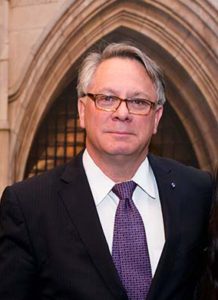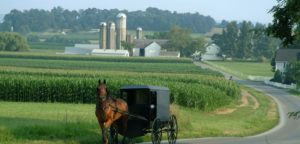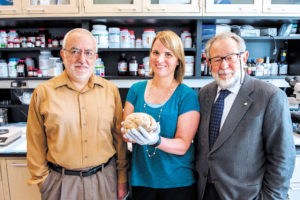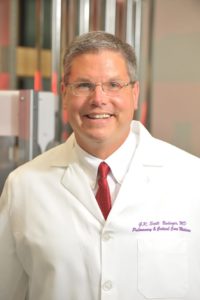For some people, age really is just a number. The complex biological changes associated with aging affect nearly every aspect of one’s health, but some people are less affected than others.
Investigators at Feinberg are studying populations that seem resistant to some of the negative consequences of aging — such as certain members of an Amish community in Berne, Indiana or a group of cognitively young octogenarians termed “SuperAgers” — in an attempt to figure out exactly what makes them different. Other scientists are interested in seeking biological levers, approaches to minimize the impact of aging and extend the healthy lifespan, or health span, of older adults.
Whether it’s improving recovery after pneumonia, which can cause functional deficits for the rest of older adults’ lives, or boosting the quality of sleep, which can redound in better cardiovascular and neurological health, Feinberg investigators are breaking down the mechanisms of aging and designing solutions to extend healthy living.
Cellular Senescence

The physical symptoms of aging are well known to all of us — skin wrinkling, hair graying and falling out —but what happens within individual cells is less obvious.
Douglas Vaughan, MD, chair and the Irving S. Cutter Professor of Medicine, has spent years studying senescence, the process of old cells losing their regenerative capabilities. The cells don’t die, but they are often less effective in repairing and preventing aging-related conditions: Arterial walls stiffen and blood pressure rises, hearing is less sensitive and lung capacity is reduced, to name a few examples.
“Nearly every organ system has a specific aging-related physiological alteration that can be measured,” Vaughan said.
Simply turning senescence off would be a fool’s errand, according to Vaughan, as restraining cell proliferation is a key safeguard against rampant cell growth and cancer. However, an extended family of Old Order Amish living in Indiana gave Vaughan a framework for what might be effective.
 Some members of this family — descended from Swiss immigrants — share a genetic mutation that causes very low levels of plasminogen activator inhibitor (PAI-1), a protein that is a marker and a mediator of cell senescence. In a study published in Science Advances, Vaughan found people that carry a single copy of this genetic variant live more than 10 percent longer and exhibit preserved cardiovascular flexibility, as well as protection from diabetes and lower fasting insulin levels.
Some members of this family — descended from Swiss immigrants — share a genetic mutation that causes very low levels of plasminogen activator inhibitor (PAI-1), a protein that is a marker and a mediator of cell senescence. In a study published in Science Advances, Vaughan found people that carry a single copy of this genetic variant live more than 10 percent longer and exhibit preserved cardiovascular flexibility, as well as protection from diabetes and lower fasting insulin levels.
Aging is a multi-morbidity condition and while there are drugs that treat selective components associated with aging — statins that lower cholesterol or ACE inhibitors that lower blood pressure — playing whack-a-mole with the multitude of aging-related conditions is an improbable task for clinicians.
“Aging is not just cancer or cardiovascular disease, selective components associated with multiple different diseases at once,” Vaughan said. “That creates a huge challenge to treat people as they age and a huge cost on our healthcare system.”
Instead, a drug such as a PAI-1 inhibitor that deals with the underlying mechanisms of aging is a much more attractive option, according to Vaughan.
“If you target the very fundamental mechanisms that drive senescence, you could have a single drug or combination of drugs that treat multiple systems and push back the onset of aging-related multi-morbidity,” Vaughan said.
Listen to a podcast with Vaughan about using a PAI-1 inhibitor in a new phase 2 COVID-19 clinical trial.
Super-Aging

Much like cardiovascular health naturally declines as people age, so does cognitive function. The hippocampus, a region important for memory, shrinks over time and the cortex, the outer region of the brain, gets thinner.
This translates into worsening episodic memory and cognitive performance, but this decline is not evenly distributed. In young people, cognitive performance is more or less the same, according to Emily Rogalski, ’07 PhD, professor of Psychiatry and Behavioral Sciences, but as people age that variability increases.
“That’s when we see individuals far below average, and that’s what we associate with pathologic aging such as Alzheimer’s dementia,” Rogalski said.
By that same token, there are people whose memory function is much better than expected. These people, termed “SuperAgers,” seem to be resistant to age-related memory decline — even in their 80s, they have similar memory function to peers in their 50s.

Surprisingly, these SuperAgers exhibited tremendous variation among traditional indicators of healthy aging, such as education, wealth and lifestyle factors like alcohol use or exercise. However, one thing that set them apart was a high population of specialized brain cells called Von Economo neurons.
These neurons are theorized to be important for social interaction: they are only found in complex species with high sociality such as elephants, dolphins and whales, and patients with dementia disorders often have substantial losses of these neurons.
SuperAgers have four to five times the number of Von Economo neurons and reduced rate of cortical thinning when compared with normal aging adults, according to a study published in JAMA, demonstrating SuperAgers have biologic differences from their average peers. In addition, SuperAgers reported more positive relations with others than average amongst peers of their age, tying back to the theme of socialization, Rogalski said.
“It shows the practical value of staying socially connected — not only does it make you feel good, but it might be good for your brain.”
There are still many questions about SuperAgers: Were they born with more Von Economo neurons? Did they acquire them at some point in their life? Either way, Rogalski continues to track their cognitive trajectory, hoping to nail down what exactly makes them “super.”
“I think there’s a lot more to come,” Rogalski said. “Understanding the biology, psychology and social aspects of SuperAging may provide practical leads for avoiding Alzheimer’s disease and living well into older age.”
Critical Points

Studying populations who exhibit resistance to age-related decline is a valuable window into how aging works and hints at future methods that could help mitigate its worst effects. However, some Feinberg investigators are doing work further down the pipeline, examining the impact of certain conditions or therapies and evaluating how they might be used to ameliorate symptoms of aging.
One critical condition in older adults is pneumonia, which can often result in hospitalization and permanent lung, muscle and neurologic decline in older adults, according to Scott Budinger, MD, the Ernest S. Bazley Professor of Airway Diseases and chief of Pulmonary and Critical Care in the Department of Medicine.
Because all the blood in the body is routed through the lungs to oxygenate, infection in the lung or pneumonia can have long lasting consequences in a variety of body systems: Older adults discharged from the hospital after pneumonia have an elevated risk for heart attack, kidney disease and dementia, to name a few.
“We think of it as a gateway to compounding multi-morbidity that limits health span at the end of life,” said Budinger, also a professor of Medicine in the Division of Pulmonary and Critical Care, of Cell and Developmental Biology, and a member of the Robert H. Lurie Comprehensive Cancer Center of Northwestern University.
According to Budinger, one contributor to this decline is age-related alterations in macrophages, highly specialized cells that live within every tissue of the body. After an infection, macrophages serve as a “garbage collector,” cleaning up excess fluid or depleted inflammatory cells that helped fight off the infection.
With advanced age, these cells become dysfunctional — and resolution of inflammation is required for healing lung injury, according to a study Budinger published in Science Advances.
“The macrophages are unable to clean up the mess, essentially,” Budinger said. “This leads to impaired healing, secondary infections, chronic inflammation and other complications.”
Slowing or reversing this decline could dramatically improve the outlook for patients hospitalized with pneumonia, and Budinger believes that restoring function in these macrophages is a promising possibility. While Budinger is examining how drugs might restore macrophage function in patients after pneumonia, other anti-aging strategies involve continuous treatment, taking a targeted approach at this critical point could be a more clinically feasible strategy, Budinger noted.
“Giving an older patient medication in the narrow window of time when they’re recovering from their pneumonia is a lot more attractive than treating them for the rest of their lives,” Budinger said.
Sleep, Aging and Pink Noise

A pneumonia hospitalization is an opportunity to intervene and extend the health span of older adults, but it isn’t the only chance. In fact, there is an opportunity every night: during sleep.
As adults age, sleep becomes more fragmented, according to Phyllis Zee, MD, PhD, ’87 ’89 GME, the Benjamin and Virginia T. Boshes Professor of Neurology. One reason the sleep cycle changes is that the deepest stage of sleep, characterized by slow oscillations in the brain, decreases with age and there is a shortening of circadian rhythm: the internal clock runs just slightly faster, Zee said.
“This could be why older individuals can’t stay asleep or are waking up at 4 a.m.,” Zee said.
Over time, sleep and circadian rhythm affect each other, amplifying mis-regulation and impacting systems throughout the body. Recent discoveries have shown poor sleep is an important risk factor for cardiovascular disease and Alzheimer’s disease.
To that end, Zee investigated the effects of using gentle sound stimulation to improve the quality of deep sleep. Publishing their findings in the journal Sleep, Zee and her collaborators found that “pink noise” boosted cardiovascular measures of sleep quality, helping neurons synchronize during deep sleep.
“I think of it like exercise or nutrition,” Zee said. “It’s an often overlooked pillar of health and improving sleep could affect multiple systems in the body.”
Healthy aging is a theme cutting across Feinberg’s research enterprise and is seen as a strategic research opportunity for investigators. As the population of Americans aged 65 and older continues to grow, predicted to double by 2050, expect to see more Feinberg research projects and initiatives take shape across departments, centers and institutes.







